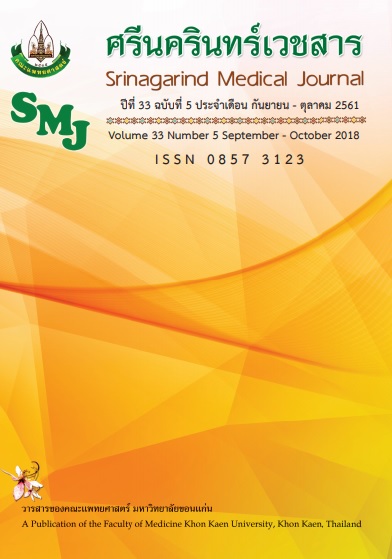ความชุกของการตั้งครรภ์โดยไม่ได้วางแผนในสตรีที่มาฝากครรภ์
Keywords:
Pregnancy, ; ตั้งครรภ์Abstract
หลักการและวัตถุประสงค์: การตั้งครรภ์ที่ไม่ได้วางแผนมักจะให้ผลการรักษาที่ไม่ดีอย่างที่ต้องการ ดังนั้นจุดประสงค์ของการศึกษาครั้งนี้เพื่อค้นหาความชุกของการตั้งครรภ์โดยไม่ได้วางแผน และปัจจัยเสี่ยงที่เกี่ยวข้องวิธีการศึกษา: ทำการศึกษาแบบตัดขวางตั้งแต่วันที่ 1 สิงหาคม 2556 จนถึงวันที่ 30 เมษายน 2557 ผู้เข้าร่วมโครงการคือหญิงตั้งครรภ์ที่มาฝากครรภ์ จำนวน 240 ราย โดยจะได้รับการสัมภาษณ์ด้วยแบบสอบถามเกี่ยวกับ 1) ข้อมูลพื้นฐาน เช่น อายุ ระดับการศึกษา สถานภาพสมรส รายได้ อาชีพและอื่น ๆ 2) ข้อมูลด้านสุขภาพทั่วไปรวมทั้ง 3) ข้อมูลทางนรีเวช
ผลการศึกษา: พบความชุกของการตั้งครรภ์โดยไม่ได้วางแผนร้อยละ 30 โดยมีค่าเฉลี่ยและค่ากลางแปรปรวนของอายุหญิงตั้งครรภ์ 28.34 ปีและ 5.39 ปี ตามลำดับ การวิเคราะห์ตัวแปรเดียวพบว่ารายได้ที่น้อย (<10,000 บาทต่อเดือน) สถานภาพโสดและประวัติการมีบุตรของผู้ป่วยมีความสัมพันธ์กับการตั้งครรภ์โดยไม่ได้วางแผน ปัจจัยเสี่ยงที่สำคัญที่สุดที่คำนวณได้จากการถดถอยโลจิสติกหลายตัวแปร ได้แก่ รายได้และประวัติการมีบุตร หญิงตั้งครรภ์โดยไม่ได้วางแผน ใช้ยาคุมกำเนิดฉุกเฉินก่อนการตั้งครรภ์บ่อยกว่าหญิงตั้งครรภ์โดยวางแผน
สรุป: ความชุกของการตั้งครรภ์โดยไม่ได้วางแผนในหญิงตั้งครรภ์ที่คลินิกฝากครรภ์อยู่ที่ร้อยละ 30 กลุ่มผู้มีรายได้ที่เท่ากับหรือน้อยกว่า 10,000 บาทต่อเดือน และประวัติการมีบุตรเป็นปัจจัยเสี่ยงที่เกี่ยวข้องกับการตั้งครรภ์โดยไม่ได้วางแผน การเข้าถึงการคุมกำเนิดได้อย่างมีประสิทธิภาพและควรให้ความรู้แก่สตรีที่มีความเสี่ยงเพื่อหลีกเลี่ยงผลลัพธ์ที่ไม่พึงประสงค์จากการตั้งครรภ์โดยไม่ตั้งใจและผลเสียที่ตามมา
References
1. Singh S, Sedgh G, Hussain R. Unintended pregnancy: worldwide levels, trends, and outcomes. Stud Fam Plann 2010; 41: 241-50.
2. Sriprasert I, Chaovisitsaree S, Sribanditmongkhol N, Sunthornlimsiri N, Kietpeerakool C. Unintended pregnancy and associated risk factors among young pregnant women. Int J Gynaecol Obstet 2015; 128: 228-31.
3. Naravage W, Vichit-Vadakan N, Sakulbumrungsil RC, Van der Putten M. Factors affecting decision making of low-income young women with unplanned pregnancies in Bangkok, Thailand. Southeast Asian J Trop Med Public Health 2005; 36: 775-82.
4. Sedgh G, Henshaw S, Singh S, Ahman E, Shah IH. Induced abortion: estimated rates and trends worldwide. Lancet 2007; 370: 1338-45.
5. Su JH. Unintended Birth and Children's Long-term Mental Health. J Health Soc Behav 2017; 58: 357-70.
6. Singh A, Upadhyay AK, Singh A, Kumar K. The Association Between Unintended Births and Poor Child Development in India: Evidence from a Longitudinal Study. Stud Fam Plann 2017; 48: 55-71.
7. Brittain K, Myer L, Koen N, Koopowitz S, Donald KA, Barnett W, et al. Risk Factors for Antenatal Depression and Associations with Infant Birth Outcomes: Results From a South African Birth Cohort Study. Paediatr Perinat Epidemiol 2015;29: 505-14.
8. Lindberg L, Maddow-Zimet I, Kost K, Lincoln A. Pregnancy intentions and maternal and child health: an analysis of longitudinal data in Oklahoma. Matern Child Health J 2015; 19: 1087-96.
9. Loeber OE, Muntinga ME. Contraceptive counselling for women with multiple unintended pregnancies: the abortion client's perspective. Eur J Contracept Reprod Health Care 2017; 22: 94-101.
10. Coombe J, Harris ML, Wigginton B, Lucke J, Loxton D. Contraceptive use at the time of unintended pregnancy: Findings from the Contraceptive Use, Pregnancy Intention and Decisions study. Aust Fam Physician 2016; 45: 842-8.
11. Hall JA, Barrett G, Phiri T, Copas A, Malata A, Stephenson J. Prevalence and Determinants of Unintended Pregnancy in Mchinji District, Malawi; Using a Conceptual Hierarchy to Inform Analysis. PLoS One 2016; 11: e0165621.
12. 12. Borrero S, Callegari LS, Zhao X, Mor MK, Sileanu FE, Switzer G, et al. Unintended Pregnancy and Contraceptive Use Among Women Veterans: The ECUUN Study. J Gen Intern Med 2017;32: 900-8.
13. Brunner Huber LR, Smith K, Sha W, Zhao L, Vick T. Factors associated with pregnancy intention among women who have experienced a short birth interval: findings from the 2009 to 2011 Mississippi and 2009 Tennessee Pregnancy Risk Assessment Monitoring System. Ann Epidemiol 2018; 28: 372-6.
14. du Toit E, Jordaan E, Niehaus D, Koen L, Leppanen J. Risk factors for unplanned pregnancy in women with mental illness living in a developing country. Arch Womens Ment Health 2018; 21: 323-31.
15. Unintended Pregnancy in the United States New York: Guttmacher Institute; 2016. [Cited September 20, 2016] Available from: https://www.guttmacher.org/sites/default/files/factsheet/fb-unintended-pregnancy-us_0.pdf.
16. Singh S, Shekhar C, Acharya R, Moore AM, Stillman M, Pradhan MR, et al. The incidence of abortion and unintended pregnancy in India, 2015. Lancet Glob Health 2018; 6: e111-e20.
17. Rottenstreich M, Loitner L, Dar S, Kedem R, Smorgick N, Vaknin Z. Unintended pregnancies among women serving in the Israeli military. Contraception 2017; 96: 62-5.
18. Wise A, Geronimus AT, Smock PJ. The Best of Intentions: A Structural Analysis of the Association between Socioeconomic Disadvantage and Unintended Pregnancy in a Sample of Mothers from the National Longitudinal Survey of Youth (1979). Womens Health Issues 2017; 27: 5-13.
19. Chanda MM, Ortblad KF, Mwale M, Chongo S, Kanchele C, Kamungoma N, et al. Contraceptive use and unplanned pregnancy among female sex workers in Zambia. Contraception 2017; 96: 196-202.
20. Morse JE, Ramesh S, Jackson A. Reassessing Unintended Pregnancy: Toward a Patient-centered Approach to Family Planning. Obstet Gynecol Clin North Am 2017; 44: 27-40.
21. 21. Goenee MS, Donker GA, Picavet C, Wijsen C. Decision-making concerning unwanted pregnancy in general practice. Fam Pract 2014; 31: 564-70.
22. Hall KS, Dalton VK, Zochowski M, Johnson TRB, Harris LH. Stressful Life Events Around the Time of Unplanned Pregnancy and Women's Health: Exploratory Findings from a National Sample. Matern Child Health J 2017; 21: 1336-48.
23. Borges ALV, Dos Santos OA, Fujimori E. Concordance between intention to use and current use of contraceptives among six-month postpartum women in Brazil: The role of unplanned pregnancy. Midwifery 2018; 56: 94-101.
24. Hohmann-Marriott BE. Unplanned pregnancies in New Zealand. Aust N Z J Obstet Gynaecol 2018; 58: 247-50.




